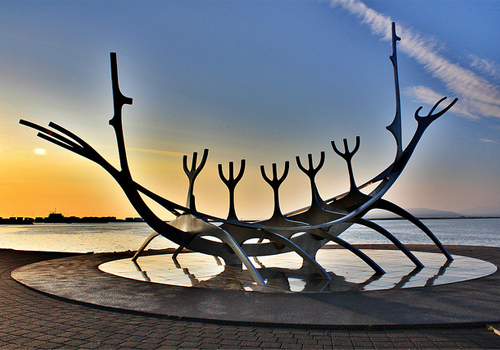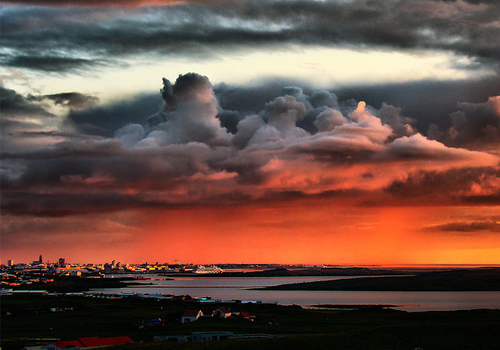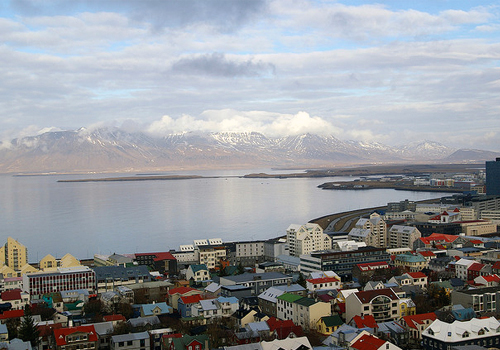Reykjavik Travel Guide
Hallgrimskirkja
Address: At the end of the Skólavörðustígur Reykjavik
Admission: ISK 900 for adults, ISK 100 for children Daily 9am-5pm (October to April) and 9am-9pm (May to September). Closed during Sunday mass.
Telephone: 510 1000
This landmark church, one of the tallest buildings in Iceland, dominates the city from its highest point and is visible on a sunny day from up to 10 miles (16km) away. Named after the 17th-century Icelandic poet, hymn composer and clergyman, Hallgrimur Petursson, the church's unusual design includes volcanic basalt columns flanking its towering steeple. It took more than 40 years to build the edifice, which was finally completed in 1986. In front of the church stands a statue of Leif Eriksson, donated to Iceland by the United States. The church is lovely inside but even those uninterested in exploring this place of worship will be impressed by the striking facade. It is possible to climb the tower for views over the city.<br /><br />
Botanical Gardens
Address: Laugardalur Valley 104 Reykjavik
Admission: Free 10am-10pm during summer, 10am-3pm during winter
Although Iceland is better known for more stark, rocky landscapes, a walk in Reykjavik's gardens will convince travellers of the country's more lush and flowery offerings. The pretty Reykjavik Botanic Garden is a haven for strollers, enshrining about 5,000 plant species, including a large collection of Icelandic indigenous plants and other plant collections, which give an idea of the enormous diversity of vegetation in the northern temperate zone. Besides walking trails and water features, the garden has a display greenhouse where a cosy café is open during the summer months. Located close to the garden is the Reykjavik Zoo and Family Park.<br /><br /> The gardens are open all year round, though opening times may vary season to season and there is less to see in the colder months. Admission is free.<br /><br />
Einar Jónsson Museum
Address: Eiriksgata 3 Reykjavik
Admission: 1000 ISK for adults, concessions available. 10am-5pm Tuesdays to Sundays
Einar Jónsson was Iceland's foremost sculptor, and he himself designed and established this museum, which contains over 300 of his works spanning his 60-year career. The museum building itself is deemed to be Jónsson's largest work, and served as his home, gallery and studio. The foundation stone was laid in 1916; it was Iceland's first art museum and retains pride of place on the highest point in Reykjavik. It is adjoined by a pristine, leafy sculpture garden, which sports about 26 bronze casts of the artist's work. There is also a museum shop selling plaster casts of Jónsson's works, books and postcards.<br /><br /> Travellers should note that the museum is closed on Mondays and for the whole of January and February. All other admission details can be found on the official website listed below.<br /><br />
Blue Lagoon
Address: 240 Grindavik, Iceland Reykjavik
Admission: 6990 ISK for the Comfort package Opening times are seasonal, but Blue Lagoon is generally open 8am to 9pm.
A favourite and unique attraction close to Reykjavik, about 30 miles (50km) southwest of the city, is the man-made geothermal 'Blue Lagoon', set in a lava field, filled with mineral-rich hot water pumped from about a mile below the surface. The lagoon is flanked by a luxurious health spa where visitors come to be pampered and treated for skin ailments like eczema and psoriasis. The lagoon's surreal phosphorescent aquamarine colour is caused by the therapeutic ecosystem of algae, silica and minerals in the water.<br /><br /> The Blueline bus company offers transport to and from the Blue Lagoon, and other transport options are outlined on the official website. Visitors should note that the Blue Lagoon is very popular and should be booked as far in advance as possible to avoid disappointment. The opening times change seasonally and can be found on the website listed below.<br /><br />
Gullfoss Falls
Address: Gullfoss National Park Reykjavik
Iceland's famed Gullfoss (Golden) Falls are justly rated among the most beautiful in the world, and make for a popular excursion from Reykjavik. The falls, with their awesome double-cascade, are incredibly powerful, which has meant they have come under threat of being utilised as a source of hydro-electricity. Currently, however, the magnificent natural water feature, shrouded in mist and rainbows and gushing into a canyon on the Hvita River, is safely ensconced in a national park and remains one of the country's top tourist attractions.<br /><br /> The falls can be visited on Iceland's famous Golden Circle route, and many tour operators and public buses make daily trips to the national park during the warmer months.<br /><br />
Geysir
Address: Geysir Center, Geysir Reykjavik
Admission: Free
The weird landscape of the Haukadalur Valley in Iceland's southern lowlands, where hot springs spout and mud pools bubble, has been dominated for centuries by the 'granddaddy' of all geysers, the Great Geysir, from which all other such phenomena around the world have gained their name. The Geysir, once shooting boiling water hundreds of feet into the air, has reduced its performance levels somewhat in modern times but is nevertheless still an impressive sight when it occasionally erupts. The rest of the thermal area, bathed in a sulphuric smell, is just as fascinating, featuring several other spouting vents and geysers which frequently display their prowess. The Geysir area has become a very popular tourist attraction, and a centre has been opened containing a multi-media geology museum and folklore exhibits. There is also a hotel, souvenir shop and restaurant on site.<br /><br />
Thingvellir National Park
Address: 801 Selfoss Reykjavik
The national park of Thingvellir, 30 miles (50km) east of Reykjavik, is not only Iceland's most important historic site, but also a place of natural and geological wonder. It was here that the world's first-ever parliament, the Alting, initially convened in AD 930, and where Christianity was first introduced to Iceland. Even today, people gather at Thingvellir to celebrate any major national event. Geologically, this is the only site in the world where the American and European tectonic plates are visible; and the park is also home to the largest lake in Iceland, and stunning scenery including a lava gorge, the Oxararfoss Waterfall, and the 'Money Chasm', where visitors drop coins down a gorge into water, to witness the strange distorted reflections that result. Activities available at Thingvellir National Park include hiking, angling, horseback riding, diving and camping.<br /><br /> The national park is open all year and in the warmer months a daily bus visits the park from Reykjavik.<br /><br />
Jökulsárlón
Address: Reykjavik
Jökulsárlón - literally, 'glacier lagoon' - is the largest glacial lake in Iceland, and an enormously popular tourist attraction. The site shot to prominence after being featured in Hollywood movies (most memorably, Batman Begins), and now attracts thousands of visitors each year. Caused by the retreat of the glacier known as Breiðamerkurjökull, the lagoon is now nearly a mile (1.5km) from the ocean's edge, and is over 814 feet (248m) deep. Most easily approached from the fishing-town of Höfn on Iceland's southern coast, visitors in search of an indelible memory of their time in Iceland should definitely make the trip to Jökulsárlón, where luminous blue icebergs float eerily across the freezing water. Whatever you do, don't forget to pack a camera - Jökulsárlón is undoubtedly one of the best sights Iceland has to offer, and in such a staggeringly beautiful country, that's really saying something.<br /><br />
Hidden People
Address: Reykjavik
Never mind the Vikings, one of Iceland's most interesting cultural drawcards must surely be the Huldufólk, or 'Hidden People'. In Icelandic folklore, the Huldufólk are akin to elves - invisible, non-threatening, magical beings, that can be observed by humans with a talent for communicating with the 'hidden realm' of being. A large proportion of Iceland's population reputedly believe in the Huldufólk and they are an important element of the country's folklore and national identity. Visitors to Iceland will gain a lot of insight into the culture by exploring the concept a little.<br /><br /> Recommended Huldufólk-related activities include a visit to Reykjavik's Hellisgerdi Lava Park (which is supposedly full of elvin homes); a trip to the Museum of Icelandic Wonders in Stokkseyri (just 37 miles/60km from the capital); and, for the really enthusiastic, a half-day course at Magnús Skarphedinsson's Álfaskólinn, the Icelandic Elf School, where you'll learn all about the 'hidden realm', and even receive a diploma to prove it.<br /><br />
Reykjavík Marathon
Where: Laekjargata, the centre of Reykjavik,Reykjavik
When: 18 August 2018
This event goes hand-in-hand with the Reykjavik Cultural Night and although international attendance at the marathon is still small, the overall cultural experience is increasing in popularity every year. The marathon has a fantastic festive atmosphere with many spectators encouraging the athletes from the sidelines. It takes place in and around the beautiful city of Reykjavik and the runners get to enjoy the scenic location of the race. Apart from the marathon there is a half-marathon, a six-mile (10km) run, and a two-mile (3km) fun run.<br /><br />
Independence Day
Where: Throughout the country,Reykjavik
When: 17 June 2018
Each year through most of the major towns and cities across Iceland, parades and musical celebrations take place to commemorate the date of Iceland attaining independence from Denmark in 1944. The day is a celebration of Icelandic culture, exploring many of the myths and traditions associated with this fascinating land. International tourists seldom travel to Iceland specifically for this event but those that happen to be in the country in June will be treated to an extravaganza of patriotism and tradition and should aim to join in the celebrations with the locals.<br /><br />
The Arctic Open
Where: Akureyri Golf Club,Reykjavik
When: 20 - 23 June 2018
The Arctic Open Golf Championship is an international event which draws golfers - both amateur and professional - and spectators from various parts of the world. Apart from the magnificent natural scenery surrounding the Akureyri Golf Club, the chief attraction of the tournament is the prospect of teeing off at 10pm thanks to the near-perpetual sunlight of the Icelandic summer. The venue has the distinction of being the northernmost golf course in the world, as recognised by the Royal Ancient Golf Club of St Andrews Golfer's Handbook.<br /><br />
Thorrablot
Where: All around the city,Reykjavik
When: Mid-January to mid-February 2018
Thorrablot, also known as the Mid-Winter Feast, sees the capital of Reykjavik and her restaurants open up to crowds of thousands, turning out menus surely concocted by the Addams Family's Lurch, or possibly, the witches from Macbeth. If the Vikings have been historically misconstrued as hairy savages who drank too much, this traditional feast might not help this reputation, but it will provide a novel experience to anybody visiting Iceland. The fare includes Hákarl (fermented shark), Hrútspungur (ram's testicles) and Svið (boiled sheep's head). Over dinner, your host might share a riveting Viking tale while you sample the foods that the empire once enjoyed. After the meal, take a swig or two of Brennivin (a very potent Icelandic Schnapps), and revel the night away with traditional dances, music and games.<br /><br />
Restaurant Lækjarbrekka
Address: Bankastræti 2 Reykjavik
Food Type: Local
Situated in one of the oldest houses in the centre of Reykjavik, Restaurant Lækjarbrekka is a classic Icelandic eatery serving traditional fare in a warm and relaxed atmosphere. Don't be shocked to find horse carpaccio or whale on the menu as these are local delicacies in Iceland. Enjoy the langoustine soup with cognac and cream, while brave diners can sample a traditional Icelandic dish, grilled steak of Minke whale with mashed potatoes and Brennivin sauce. After dinner retire upstairs to the bar and cognac room to sip on an aperitif and enjoy the Icelandic hospitality. Open daily for lunch and dinner. Bookings recommended.<br /><br />
3 Frakkar
Address: Baldursgata 14, Reykjavik Reykjavik
Food Type: Seafood
A restaurant perpetually full, and always full of local Icelanders, 3 Frakkar has been described at the 'best-kept secret' of the Reykjavik restaurant scene. Tucked away in a residential neighbourhood, the restaurant is cosy and quaint, and has a world-famous selection of (mainly) fish and seafood dishes. An ideal venue for a date, be sure to book well ahead.<br /><br />
Kaffi Loki
Address: Lokastigur 28 Reykjavik
Food Type: Café
Named after the Norse god of mischief, Kaffi Loki is a cosy little place for a quick lunch or a slice of cake. It's centrally located just across the street from Halgrimskirkja and has a beautiful mural depicting its namesake. Try the rye bread ice cream for a unique taste experience or more traditional Icelandic fare like fermented shark. Open daily for breakfast, lunch and dinner.<br /><br />
Fiskfelagid (Fish Company)
Address: Vesturgotu 2a Reykjavik
Food Type: International
Fine dining in Iceland is typically centered on the incredibly fresh and wholesome seafood. Fiskfelagid makes the most of these assets with their celebrated cuisine served in stylish surrounds. Try the "tour of Iceland" which is a tasting menu of modern interpretations of traditional dishes. The lobster pizza is also interesting. The service is friendly and skilled.<br /><br />
(Data provided outside US and Canada by Foreca, Data provided for US and Canada by WDT)
| Jan | Feb | Mar | Apr | May | Jun | Jul | Aug | Sep | Oct | Nov | Dec | |
| Average High | 1° | 2° | 2° | 5° | 8° | 11° | 12° | 12° | 9° | 6° | 3° | 2° |
| Average Low | -2° | -1° | -1° | -- | 3° | 6° | 8° | 7° | 5° | 2° | -- | -2° |
(Data provided outside US and Canada by Foreca, Data provided for US and Canada by WDT)
| Jan | Feb | Mar | Apr | May | Jun | Jul | Aug | Sep | Oct | Nov | Dec | |
| Average High | 35° | 37° | 37° | 41° | 47° | 52° | 55° | 54° | 49° | 44° | 38° | 36° |
| Average Low | 27° | 29° | 29° | 33° | 39° | 44° | 47° | 46° | 41° | 36° | 31° | 28° |


